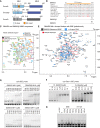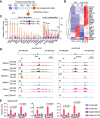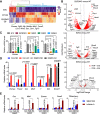Structural basis for distinct roles of SMAD2 and SMAD3 in FOXH1 pioneer-directed TGF-β signaling
- PMID: 31582430
- PMCID: PMC6824466
- DOI: 10.1101/gad.330837.119
Structural basis for distinct roles of SMAD2 and SMAD3 in FOXH1 pioneer-directed TGF-β signaling
Abstract
TGF-β receptors phosphorylate SMAD2 and SMAD3 transcription factors, which then form heterotrimeric complexes with SMAD4 and cooperate with context-specific transcription factors to activate target genes. Here we provide biochemical and structural evidence showing that binding of SMAD2 to DNA depends on the conformation of the E3 insert, a structural element unique to SMAD2 and previously thought to render SMAD2 unable to bind DNA. Based on this finding, we further delineate TGF-β signal transduction by defining distinct roles for SMAD2 and SMAD3 with the forkhead pioneer factor FOXH1 as a partner in the regulation of differentiation genes in mouse mesendoderm precursors. FOXH1 is prebound to target sites in these loci and recruits SMAD3 independently of TGF-β signals, whereas SMAD2 remains predominantly cytoplasmic in the basal state and set to bind SMAD4 and join SMAD3:FOXH1 at target promoters in response to Nodal TGF-β signals. The results support a model in which signal-independent binding of SMAD3 and FOXH1 prime mesendoderm differentiation gene promoters for activation, and signal-driven SMAD2:SMAD4 binds to promoters that are preloaded with SMAD3:FOXH1 to activate transcription.
Keywords: FOXH1; SMAD2; SMAD2 structure; SMAD3; TGF-β signaling; embryonic stem cell; mesendoderm differentiation; pioneer transcription factor.
© 2019 Aragón et al.; Published by Cold Spring Harbor Laboratory Press.
Figures







References
Publication types
MeSH terms
Substances
Grants and funding
LinkOut - more resources
Full Text Sources
Other Literature Sources
Molecular Biology Databases
Miscellaneous
